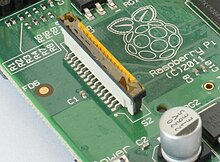Display serial interface
The Display Serial Interface ( DSI ) is a specification from the MIPI Alliance that reduces the cost of display controllers in a mobile device. It is generally geared towards LCD and similar display technologies. DSI defines a serial bus and a communication protocol between the host (source of the image data) and the device (destination of the image data).
design
On the physical layer, DSI denotes a fast serial and differentially implemented point-to-point bus. This bus consists of a high-speed clock lane (line pair) and one or more data lanes. With the exception of the bidirectional lane 0, which can work in bus turnaround mode (BTA), all lanes (line pairs) run from the DSI host to the DSI device. The image data to be transmitted are distributed over the number of data lanes available.
The DSI connection works either in low-power (LP) or in high-speed (HS) mode. In LP mode, the clock line is deactivated and the clock is instead embedded in the data. The data rate in this mode is too low to drive a display, but it is sufficient for configuration information and control commands. In HS mode, the clock line clocks the transmission on the data lines. The clock frequency depends on the requirements of the display used, with the HS mode operating in a power-saving manner despite the high frequencies due to its differential structure.
The communication protocol describes two sets of commands. The Display Command Set (DCS) consists of general commands for controlling the display, the format of which is specified by the DSI standard. It defines registers and their operation, as well as basic commands such as sleep, enable and inverting the display. The Manufacturer Command Set (MCS) is a device-specific command area that is defined by the display manufacturer. It often contains commands such as for programming non-volatile memory, setting certain display registers (e.g. for gamma correction) or performing actions not described in the DSI standard. The format of both sentences is determined by the DSI standard. There are so-called short packets (4 bytes in length) and long packets (up to 2 16 bytes), each composed of a DataID, Word Count, Error Correction Code (ECC), Payload (actual data) and checksum (CRC). Host commands for reading back data from the display trigger a BTA event (bus turnaround). A display itself cannot initiate a transmission; it can only respond to host requests.
The image data on the bus is sent with horizontal and vertical blanking intervals , and is also drawn on the display in real time and not saved by the device, which enables simpler displays without a frame buffer . On the other hand, the display has to be refreshed permanently (with 30 or 60 images per second), otherwise it will lose the image. Image data is only sent in HS mode. In HS mode, commands are transmitted during the vertical blanking interval.
Web links
- mipi.org - Display Interface Overview - MIPI Alliance press release
